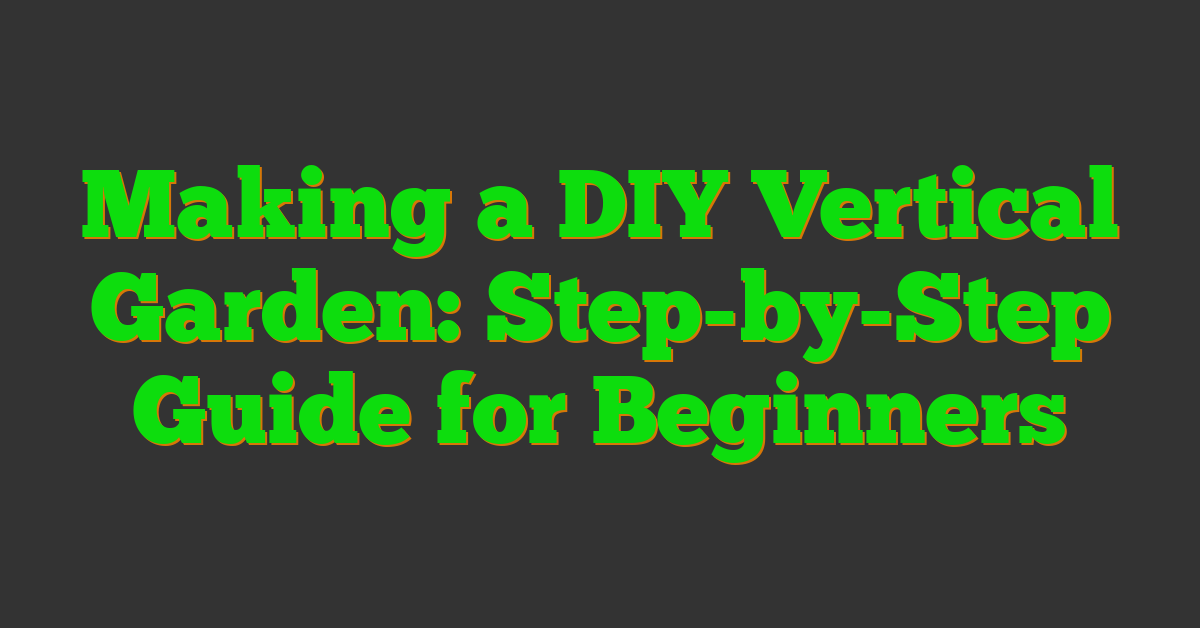Creating a vertical garden was something I never thought I’d try, but it turned out to be a game-changer for my space. With limited room, I wanted a way to bring greenery into my home without sacrificing floor space. That’s when I decided to dive into the world of DIY vertical gardening.

The process was surprisingly simple and incredibly rewarding. From choosing the right materials to selecting the perfect plants, each step was a fun adventure. Whether you’re a seasoned gardener or just starting out, setting up your own vertical garden can transform your space and boost your mood.
Benefits Of Making A DIY Vertical Garden
Creating a DIY vertical garden offers numerous advantages that enhance both living spaces and personal well-being.
Space Efficiency
Maximizing limited areas, vertical gardens enable plant growth without occupying floor space. For example, I installed shelves on my balcony to grow herbs and flowers, effectively utilizing the vertical plane.
Improved Air Quality
Plants filter pollutants, increasing oxygen levels and reducing toxins. Studies from the NASA Clean Air Study show that certain indoor plants can remove up to 87% of air toxins within 24 hours.
Cost Savings
Building a vertical garden yourself minimizes expenses associated with purchasing pre-made systems. By repurposing materials like old pallets and containers, I reduced costs while creating a personalized garden setup.
Enhanced Aesthetics
Vertical gardens add visual appeal, transforming plain walls into vibrant green displays. I noticed a significant improvement in my home’s appearance after installing a variety of colorful plants.
Increased Plant Variety
Growing vertically allows for a diverse range of plants in a compact space. I successfully cultivated vegetables, herbs, and ornamental flowers together, enhancing the garden’s diversity.
Easy Maintenance
Vertical gardens simplify watering and care routines. Installing a drip irrigation system made it easier to maintain consistent moisture levels for all my plants.
Boosted Mental Health
Interacting with greenery has been linked to reduced stress and improved mood. Tending to my vertical garden provides a relaxing and rewarding pastime.
Higher Yields
Vertical gardening can increase crop yields by providing more growing space per square foot. I harvested twice as many tomatoes and peppers compared to my previous horizontal garden setup.
Accessibility
Vertical gardens make gardening accessible to individuals with limited mobility or those who prefer gardening at eye level. Designing my vertical garden allowed me to tend to plants without bending or kneeling.
Sustainability
Using recycled materials and efficient watering systems promotes environmental sustainability. My DIY vertical garden incorporates sustainable practices, reducing waste and conserving water.
| Benefit | Description |
|---|---|
| Space Efficiency | Utilizes vertical space, ideal for small areas |
| Improved Air Quality | Filters pollutants, increases oxygen levels |
| Cost Savings | Reduces expenses by repurposing materials |
| Enhanced Aesthetics | Transforms walls into vibrant green displays |
| Increased Plant Variety | Accommodates diverse plant types in a compact space |
| Easy Maintenance | Simplifies watering and care with efficient systems |
| Boosted Mental Health | Reduces stress, improves mood through interaction with plants |
| Higher Yields | Maximizes crop production per square foot |
| Accessibility | Makes gardening easier for all individuals, regardless of mobility |
| Sustainability | Promotes eco-friendly practices through recycling and water conservation |
Choosing The Right Materials
Selecting the right materials ensures your vertical garden thrives. Here are the essential tools and container options I use.
Tools You Need
- Drill: Facilitates mounting and assembling components.
- Screws: Secures structures firmly.
- Measuring Tape: Ensures accurate placement and alignment.
- Level: Guarantees your garden stands straight and balanced.
- Gardening Gloves: Protects hands during assembly and planting.
- Staple Gun: Attaches fabric or mesh to frames securely.
Selecting Containers
- Material: Opt for weather-resistant options like plastic, metal, or recycled materials.
- Size: Ensure containers accommodate root growth and prevent overcrowding.
- Drainage: Select containers with adequate drainage to avoid waterlogging.
- Weight: Balance sturdiness with portability for easy maintenance.
- Design: Match container style with your garden’s overall look for a cohesive appearance.
Planning Your Vertical Garden
Planning ensures your vertical garden thrives and complements your space. I focus on two key aspects: selecting the location and choosing the right plants.
Selecting The Location
Choosing the right spot sets the foundation for your vertical garden’s success. I consider sunlight exposure, ensuring the area receives at least 4-6 hours of direct sunlight daily. If natural light is limited, I install grow lights to support plant growth. I also assess accessibility for easy maintenance and watering. Structural support is crucial; I select sturdy walls or freestanding frames that can bear the garden’s weight. Additionally, I evaluate proximity to water sources to streamline irrigation.
Choosing Plants
Selecting appropriate plants ensures your vertical garden flourishes. I prioritize plants based on sunlight requirements and climate compatibility. For sunny locations, I include herbs like basil and thyme, and flowers such as petunias and marigolds. In shaded areas, I opt for ferns, pothos, and begonias that thrive with less light. I balance aesthetics and functionality by mixing trailing plants with upright varieties. Considering maintenance levels, I choose low-maintenance species if I have a busy schedule, ensuring my vertical garden remains vibrant and healthy.
Building Your DIY Vertical Garden
Creating your vertical garden involves a few straightforward steps. I found assembling and planting to be both enjoyable and rewarding.
Assembly Steps
- Choose a Structure
Select a frame such as a wooden pallet, metal grid, or hanging pots based on your space and design preferences.
« Essential Winter Care Tips for Landscaping in Cold Climates How Landscaping Is Going Green: Sustainable Practices for Eco-Friendly Gardens »
- Prepare the Frame
Ensure the structure is sturdy. Sand any rough edges and apply a weather-resistant seal if placed outdoors.
- Install Mounting Hardware
Attach hooks, brackets, or screws to secure the frame to a wall or fence. Verify it can support the garden’s weight.
- Add a Waterproof Layer
Line the back and sides with plastic sheeting to prevent moisture damage to your wall and maintain plant health.
- Insert Plant Containers
Attach pots, pockets, or shelves to the frame. Space them evenly to allow adequate airflow and light exposure.
- Set Up Irrigation
Install a drip irrigation system or use self-watering containers to simplify watering and ensure consistent moisture levels.
Planting Techniques
- Select Suitable Plants
Choose plants that thrive in vertical setups, such as herbs, succulents, and trailing flowers. Consider sunlight and climate compatibility.
- Use Quality Soil
Fill containers with well-draining potting mix to promote healthy root growth and prevent waterlogging.
- Space Plants Appropriately
Arrange plants with enough room for growth. Overcrowding can lead to poor air circulation and increased disease risk.
- Implement Companion Planting
Pair plants that benefit each other, like basil with tomatoes, to enhance growth and deter pests naturally.
- Prune Regularly
Trim excess foliage to maintain plant shape and encourage new growth. Regular pruning also helps manage the garden’s overall appearance.
- Monitor and Adjust
Keep an eye on plant health and make necessary adjustments to watering, lighting, or placement to ensure your vertical garden thrives.
Maintenance And Care
Keeping a vertical garden thriving involves several key tasks:
- Watering
I water my garden 2-3 times a week using a drip irrigation system to maintain consistent moisture.
- Pruning
I trim dead leaves and pinch back stems monthly to promote healthy growth and prevent overcrowding.
- Pest Control
I inspect plants weekly for pests and use organic treatments, such as neem oil, when needed.
- Fertilizing
I apply a balanced, water-soluble fertilizer every four weeks during the growing season for essential nutrients.
- Drainage Management
I ensure proper drainage by checking excess water flows freely, which prevents root rot.
- Light Adjustment
I rotate the garden occasionally to balance sunlight exposure, ensuring all plants receive adequate light.
Design Ideas And Inspirations
Creating a unique vertical garden involves choosing designs that reflect your personal style and meet your space requirements. Here are several ideas to inspire your DIY project:
Vertical Planter Options
I consider various planter types to maximize space and functionality:
- Pallet Gardens: Utilize repurposed wooden pallets for a rustic look and ample planting space.
- Hanging Pots: Suspend pots at different heights to add depth and accommodate trailing plants.
- Trellis Systems: Install trellises for climbing plants like beans and cucumbers, enhancing vertical growth.
- Pocket Planters: Use fabric pockets for easy access and organization of smaller herbs and flowers.
Color and Plant Selection
Choosing the right colors and plants creates a visually appealing garden:
- Monochromatic Schemes: Combine different shades of green for a harmonious and calming effect.
- Complementary Colors: Mix vibrant flowers like reds and yellows with green foliage to make plants stand out.
- Seasonal Blooms: Select plants that flower in various seasons to ensure year-round interest.
Structural Designs
Incorporate different structures to add variety and support plant growth:
- Geometric Patterns: Arrange planters in shapes like squares or hexagons for a modern aesthetic.
- Tiered Layers: Create multiple levels to accommodate plants with varying height requirements.
- Multi-Panel Systems: Use interconnected panels to cover larger wall spaces efficiently.
Lighting Solutions
Proper lighting enhances plant health and garden beauty:
| Lighting Type | Benefits | Ideal Plants |
|---|---|---|
| Natural Light | Maximizes photosynthesis and growth rates | Sun-loving herbs and vegetables |
| LED Grow Lights | Provides consistent light in low-light areas | Leafy greens and succulents |
| Solar-Powered Lights | Eco-friendly and cost-effective | Decorative flowers and ferns |
DIY Decorations
Personalize your vertical garden with creative decorations:
- Decorative Pots: Choose pots with unique textures or colors to add character.
- Garden Ornaments: Incorporate small statues, fairy lights, or mirrors to enhance visual interest.
- Labeling Systems: Use stylish labels to identify plant varieties and add an organized look.
Mixed Planting Strategies
Combine different plant types for a balanced and resilient garden:
- Herbs and Vegetables: Plant basil, mint, and cherry tomatoes together for a productive space.
- Flowers and Foliage: Mix marigolds with ferns to create texture and color contrasts.
- Shade and Sun Plants: Group plants based on their light requirements to optimize growth conditions.
These design ideas and inspirations help tailor your vertical garden to fit your space, style, and gardening goals effectively.
Conclusion
Creating my vertical garden was a game-changer for my space. It’s amazing how a few simple steps can bring so much life and color into your home.
I encourage you to give it a try. You’ll not only enhance your living area but also find joy in watching your plants thrive. Happy gardening!
















